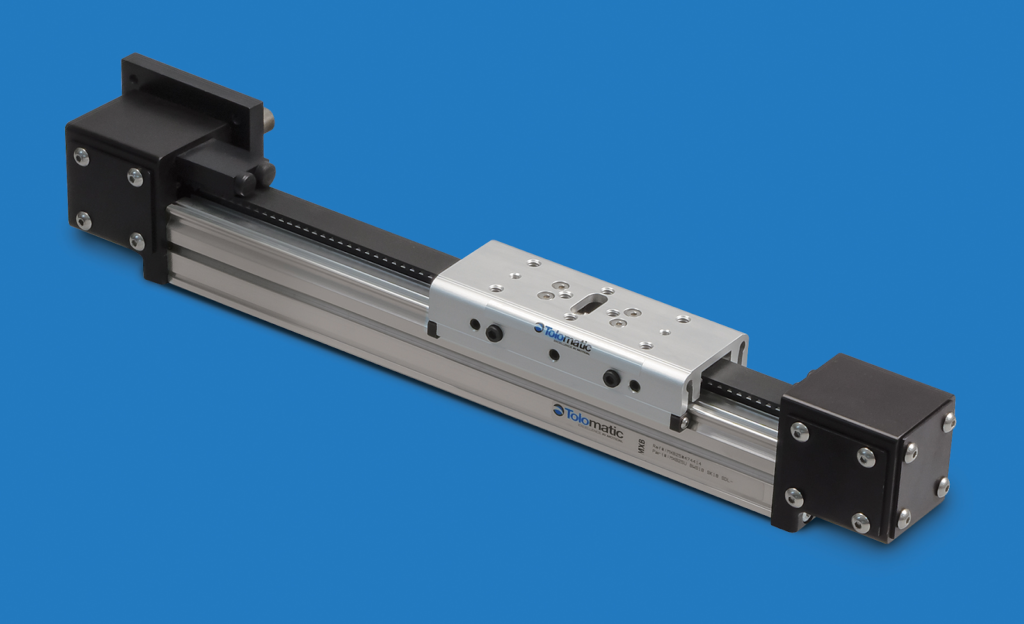Linear actuators are electro-mechanical or mechanical devices, which provide sometimes limited or controlled movements or positioning. You can operate them manually, electrically, or by various fluids like air, hydraulic, etc. There are two basic motions: rotary and linear. Linear actuators transform energy into straight lines and have a pull and a push function. There are 4 main types of linear actuators:

Contents
4 Types of Linear Actuators
1. Electric actuators
Electric actuators are such devices which are mechanical. The electricity powers these mechanisms. They consist of linear guides, motors, and drive mechanisms. These items convert electrical energy into the linear displacement. They do it via electromagnetism, mechanical transmission, or thermal expansion to provide straight line a pull/push motion.
How does electric actuator work?
The mechanism of electric actuators work is simple. It has an electric motor, generating power as soon as the electrical current passes. The motor provides the lead screw with enough power. Hence, it is able to move in the rotary motion, producing a to-and-fro motion.
Where do we apply electric linear actuators?
We can use electric linear actuators in automation applications. Also, we can utilize them in a huge number of industries where we need positioning. We are able to drive actuators with a help of several means such as lead or ball screws, belts, or voice coils. We can apply these devices in locking doors, opening/closing dampers, braking machine motions, etc. People utilize electric linear actuators, also, in DRS or cruise control.
2. Pneumatic actuator
This actuator assists in transforming the energy made by vacuum into linear or rotary motion. It is an ideal tool to turn off or start an engine. It is due to the fact that pneumatic actuators tend to exert a huge amount of energy for the minimal pressure changes. There are such valves in the pneumatic actuators, which are responsible for the flow of liquid control if you need it.
We can divide such actuators into two sub-categories: rod-type and slider-type.
– Slider-type pneumatic actuators. The actuator makes motion within the limits of a housing. The load and slide are close to each other.
– Rod-type pneumatic actuators. The rod, which retracts and extends from the housing, produces a motion. The load is at the end of the rod, or you can use the rod to push the load.
What guides the pneumatic linear actuators?
Plain bearings or recirculating guide slider-type pneumatic actuators, depending on the aim of their load design. Rod-style versions utilize simple plain bearings in order to provide the guidance to the rod. They do it with no huge contributions to the load-carrying capacity.
3. Mechanical actuators
These actuators transform the rotary motion into the linear motion. The power source of this mechanism is external, meaning you start it by your hands. The mechanisms of it are the screw, the wheel and axle, and the cam. There might be several types of the screw like roller screw, ball screw, or lead screw designs. Rotating the nut is moving the screw shaft in the straight line. In the wheel and axle, for example, rotating the wheel produces the linear motion along a chain, belt, cable, or rack. In the cam, the eccentrically shaped wheel rotates, producing the linear motion.
How do various screws work?
– Ballscrews consist of the nut and the screw and have ball bearings that are inside the nut. Therefore, the screw is able to rotate inside the nut having a very little friction. Hence, the linear actuator can move with very small loss of the force due to friction. Also, it can move longer duty cycles and at higher speeds with no overheating. However, these devices are very noisy though.
– Lead screws have a more basic design. The screw and the nut thread directly to each other. The threads of the screw and the nut are in direct contact since there are no bearings. Hence, the friction is significant.
4. Hydraulic actuator
These are such devices that operate on oil pressure. Hydraulic actuator has a working piston-cylinder system, which utilizes the hydraulic power in order to produce the motion. They are able to produce rotary, linear, or even oscillatory motion. There are a pump, a reservoir, and a valve. These are the components of the hydraulic system, which help in the production of the linear motion. The oil gives the direction to the oil flow, helping direct the piston motion. The working mechanism of it is very simple. As soon as the oil is in the piston, it begins to move in the opposite direction. There is a spring close to the piston, forcing it to give the return stroke. This is how the piston works in and out. Besides, hydraulic actuators are able to operate in reverse direction.
Where do we apply hydraulic linear actuators?
People use such actuators in power steering, construction appliances, etc. Also, such sectors as heavy-duty machine tools in engineering vehicles, precision control systems, marine, and aerospace applications utilize these mechanisms.
What are the main cons purchasing hydraulic linear actuators?
Among the disadvantages are heat, noise, leakage issues, the need for extra equipment like release valves, fluid reservoirs, motors and pumps, and the special tools to reduce heat and noise.
All in all, the number of sectors that can utilize these devices is growing more and more every year. There are many projects of such tools to be made in future to make people’s lives easier. What is more, investing in the linear actuators is a good decision because it is a long-term solution to many problems.
Recommended Post:
